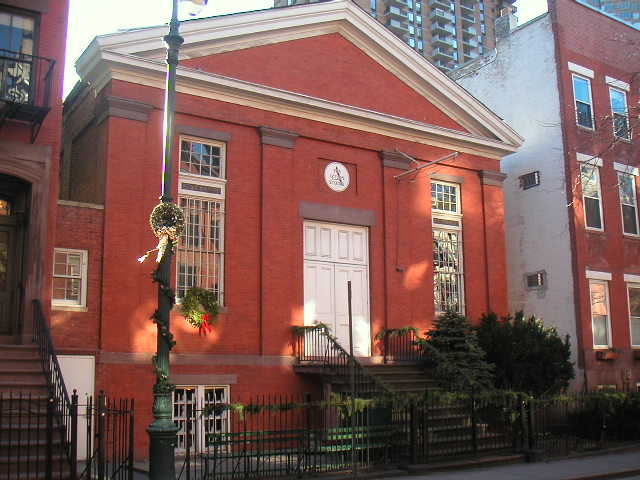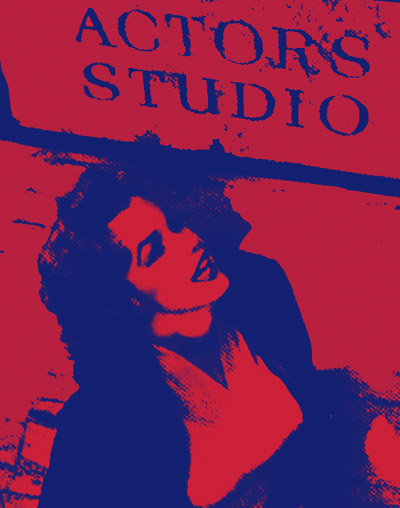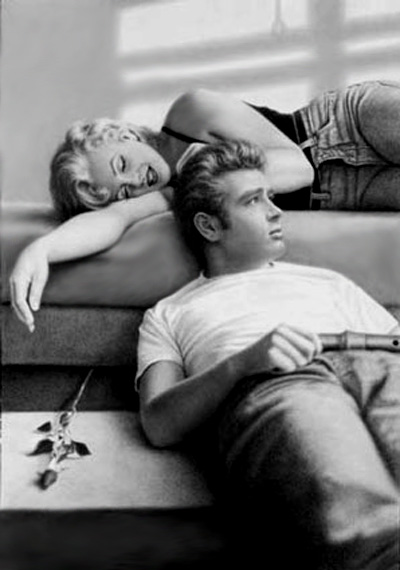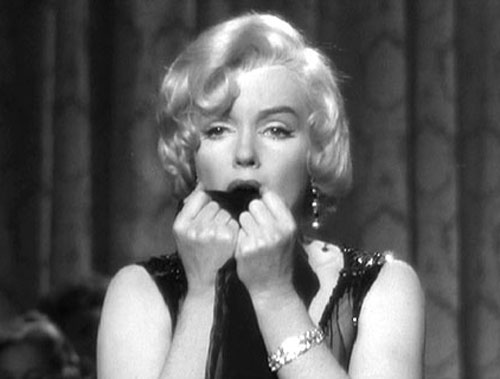 |
New York
Architecture Images- Midtown Actor’s Studio |
|||||
|
architect |
unknown | |||||
|
location |
432 W44, bet. Ninth and Tenth Aves. | |||||
|
date |
c. 1850 | |||||
|
style |
Neoclassical (founded 1947 in a former chapel) | |||||
|
construction |
brick | |||||
|
type |
Theater | |||||
|
images |
 |
|||||
|
|
  |
|||||
  |
||||||
|
The Actors Studio is a membership organization for professional actors,
theatre directors and playwrights located in the Old Labor Stage at 432
West 44th Street in the Hells Kitchen neighborhood of Manhattan in New
York City. Founded in 1947 by Elia Kazan, Cheryl Crawford, and Robert
Lewis, the Studio is known for its work refining and teaching method
acting, an approach originally developed by the Group Theatre in the
1930s based on the innovations of Constantin Stanislavski. The Studio came to worldwide recognition under the leadership of Lee Strasberg, who took over the helm in 1952. While at the Studio, actors work together to develop their skills in an experimental environment, where they can take risks as performers without the pressure of commercial roles. The Actors Studio Drama School From September 1994 through May 2005, the Studio collaborated with The New School in the education of masters-level theater students at the Actors Studio Drama School (ASDS). In 2005, New School President Bob Kerrey chose not to renew a contract with the Actors Studio, ending the collaboration and causing much controversy. Since fall 2006, the Actors Studio has offered a three-year MFA degree program through Pace University. [1] The television program Inside the Actors Studio airs on the cable television network Bravo. It is hosted by James Lipton, Dean Emeritus of the Actors Studio Drama School, and provides in-depth interviews with actors, directors, writers, and other artists, some of whom are members of the Studio. The program was taped in front of the students of ASDS, and served as a class seminar for them, until the school's dissolution. Beginning with the twelfth season, in the fall of 2005, Inside the Actors Studio is taped at the Michael Schimmel Center for the Arts at Pace University's New York City campus. |
||||||
|
Actor's Studio actors
Anne Bancroft, Marlon Brando, Monty Clift, James Dean, Robert Duval, Jane Fonda, Karl Malden, Paul Newman, Al Pacino, Geraldine Page, Eva Marie Saint, Rod Steiger, Joanne Woodward, Julia Roberts, Meg Ryan, Anthony Quinn, Willem Dafoe, Billy Crystal, Harvey Keitel, Shirley MacLaine, Eli Wallach, Anne Jackson, Lauren Bacall, Martin Short, Sir Anthony Hopkins, Danny Glover, Whoopi Goldberg, Jack Lemmon, Gary Sinise, Kathy Bates, Robert De Niro, Susan Sarandon, Meryl Streep, John Hurt, Laurence Fishburne, Donald Sutherland, Ron Howard, Sharon Stone, Sean Penn, Steven Spielberg, Tim Robbins, Jennifer Jason Leigh, Kim Basinger, Ellen Barkin, Peter Falk, Jerry Lewis, Billy Joel, Mary Tyler Moore, Sylvester Stallone, Tom Hanks, Geena Davis, Bernadette Peters, James Woods, Andy Garcia, Sir Michael Caine, Kevin Spacey, Alan Alda, Harrison Ford, Sigourney Weaver... |
||||||
|
notes
|
||||||
|
Lee Strasberg - a portrait on the 100th anniversary of his birthday By Karen Kondazian
His name has also become synonymous to those who never worked with him but only heard the 'Stories,' of a man who could make grown men weep, who wielded the power to say 'who had it and who didn't,' a giant who could grant the sought after privilege of becoming a member of that exclusive 'club' called the Actors Studio. AT 14 YEARS OLD I decided to become a member of the Actors Studio. After all, my favorite actors, Marlon Brando and James Dean were members, so why not? It seemed perfectly easy.... Go to the Actors Studio and ask Mr. Strasberg-- ("Lee", my monthly issue of Theater Arts Magazine said he was called by the people who knew him)-- and tell him to let me in. So I carefully memorized the address 432 West 44th Street and prepared myself to meet the great man, arriving at the Studio with my supportive mother in tow. A very tall man leaned down and smiled at my request-- Mr. Strasberg was not available and anyway I was too young to audition. (My first professional rejection!) But, he continued saying, that if I finished school and still loved theater and acting passionately, I could come back. And perhaps..... It became 1974 faster than I thought possible. There I was, back at the Studio. I had actually passed my 'Preliminary' audition. I had been studying with Lee in his Master Class, paying for it by teaching voice and speech for the Institute. "You have played too many Queens, darling," he said to me one day.(I had just arrived from studying in London at LAMDA.) "You must unbutton this high neck white dress you wear as an actress and learn to roll around in the mud." So roll, in his classes, I did. For my 'Final' for the Studio, I prepared for weeks in an emotional haze. I knew by now that many auditioned for Lee but few were called. On the day, I walked onto the Studio stage and glared into the darkness. Somehow, the theater angels lifted me into that place that all actors pray for--I heard a woman's voice say "Thank you," and it was done. One week later a letter arrived with the Studio logo..."Congratulations, you are a member of the Actors Studio." (A lifetime member, no fees, moderated by the great Lee!!) ....Little did I dream in 1974 that today, 2001, I would be writing an article for Lee's Centennial. ISRAEL LEE STRASSBERG was born on November 17, 1901, in Budanov, Austria-Hungary, the youngest of four children. The Strassbergs immigrated to the United States in 1909. They lived in the Lower East Side of New York and as a teenager 'Lee' began acting in plays and directing at the Students of Arts and Drama at the Chrystie Street Settlement House. After obtaining his first job in a theatrical wig factory, he started to take acting lessons with Richard Boleslavsky and Maria Ouspenskaya at the American Laboratory Theater in New York City, both of whom had studied with Konstantin Stanislavski, the founder of the Moscow Art Theater and teacher equated with a style of acting that Strasberg later built into "The Method." Strasberg made his professional acting debut in 1924, as the First Soldier in "Processional," a Theater Guild production. In 1931, he Co-founded the now-legendary Group Theater with Harold Clurman and Cheryl Crawford to establish a theater where plays would be produced for their artistic rather than commercial value. As Co-Founder, he was able to aid in the development of such distinguished artists as Eli Kazan, John Garfield, Stella Adler, Sanford Meisner, and Robert Lewis. After the Group disbanded in 1941, Strasberg joined the Actors Studio in 1949 and shortly thereafter became the Artistic Director. The list of actors who are members of the Actors Studio and studied under Strasberg's tutelage is staggering (to name a few--Marlon Brando, James Dean, Al Pacino, Paul Newman, Dustin Hoffman, Robert DeNiro, Joanne Woodward, Marilyn Monroe, Geraldine Page, Ellen Burstyn, Eva Marie Saint, Shelley Winters, Julie Harris, Karl Malden, Sally Fields. Rod Steiger. Eli Wallach, Kim Stanley, Anne Bancroft, Jack Nicholson, Steve McQueen...and this is the short list.) Early in 1966, a West Coast branch of the Actors Studio was established in Los Angeles. In 1969 The Lee Strasberg Institute was created In New York and in 1972 a school was built in Los Angeles. Lee Strasberg, the
actor: Karnen Kondazian's
personal experiences with Strasberg: Others who experienced
Lee Strasberg: THE ACTORS STUDIO METHOD ACTING LEE GRANT, Academy Award winning actress and director spoke about Strasberg's acting as well as his teaching saying, "Strasberg's influence on great talent like Burstyn and Pacino is indisputable. Lee was a fascinating foe and good friend. He was an extraordinary actor in his own light. For me his own greatest lessons were his own mysteriously personal performances." MARK RYDELL, Academy Award Nominated Director, who is the West Coast Artistic Director of the Actors Studio, shared a personal story about Lee: "I directed my first play at the Actors Studio in the late 50's. The cast was Roscoe Lee Browne and Billy Gunn playing two primitive blacks who sold clams to boaters off a dock in South Carolina. We rehearsed for months and presented the play, "Bohikee Creek" by Robert Unger, fully staged. It was a shattering experience. I was in tears when it was over, as were most of the audience. Lee, as was his habit, asked for the director to appear and to respond to the audience and his questions. It took me a minute or two to pull myself together so that I wasn't weeping when I appeared in front of this distinguished audience -- Joe Mankiewiez, Molly Kazan, and a full house of Actors Studio members. I still remember Lee's first words. They ring in my ears as I say this, "Today we have been privileged to witness the birth of a real director." I can never repay him for that vote of confidence which has lived within me these past fifty years. He was a great man, and I'm here to testify to that fact." SHIRLEY KNIGHT, Academy Award Nominated Actress spoke about Lee and the Studio."I met Lee Strasberg in 1962. I was referred to him by my costars in the film SWEET BIRD OR YOUTH Paul Newman and Geraldine Page. I wanted to study privately with him. He had seen the film when it was shown in New York as a benefit for the Actor's Studio. He agreed to see me and took me on for his classes at Carnegie Hall. After studying privately with him for two years and being an observer at the Studio he said I could audition for the Studio. After three auditions I was accepted. I relate this story because the criteria for admission to the Studio at that time was not as lax as it is today. People were not invited to join based on public celebrity. Lee set a different standard and he was not willing to admit me until he felt I was ready. The fact I had two Academy Award nominations before we met did not mean I was an automatic member. I earned my stripes by doing masses of scenes as an observer, never missing a class and constantly improving my craft. I was rewarded by playing Irina in his Broadway production of THE THREE SISTERS in 1964. Lee was a strong taskmaster and demanded the best from you. He knew more about acting than anyone I have ever met." LESLEY ANN WARREN, Actress and member of the Studio talked to us about his teaching: "Lee Strasberg was my mentor, my teacher and my inspiration. His brilliance manifested in my lifelong dedication to the discipline of The Method, as well as holding fast to the exquiste honor of being an actor and everything that he passionately believed that to be. I was always afraid of him and desperate for his approval, but in the ten years that I was lucky enough to study with him, I was molded as an artist. One of my fondest memories was when I was 19 and starring in my first Broadway musical. We were in Philadelphia and I had gotten horrible reviews. I called Lee, crying my eyes out, not knowing what to do. He flew there, saw the show and spent the next several hours admonishing me for not doing enough specific work on the character. He had me write a 40 page history of the role. Surffice it to say I did it, and went on to garner raves . It is always with gratitude and the deepest love in my heart that I know I was blessed to be in the presence of my friend and teacher Lee Strasberg." KIM STANLEY, the great American actress who passed away in August 2001, had this to say about Lee: "Lee made it possible for the whole world to open up for me." DAVID LEE STRASBERG on
his father This article was published with the kind
permission of Karen Kondazian on December 5, 2001. |
||||||
| http://www.actors-studio.com | ||||||